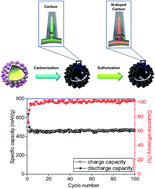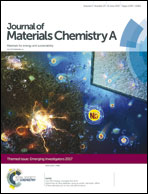A binary metal organic framework derived hierarchical hollow Ni3S2/Co9S8/N-doped carbon composite with superior sodium storage performance†
Abstract
A binary Ni/Co metal organic framework (Ni–Co-MOF) with a hollow-sphere structure that is decorated with cone-shaped protrusions was prepared via a facile solvothermal reaction. Carbonization and sulfurization of the Ni–Co-MOF produced a Ni3S2/Co9S8/N-doped carbon composite that retained the hierarchical structure. The final composite material presents exceptional electrochemical performance when used as an anode in sodium-ion batteries. A reversible specific capacity of 419.9 mA h g−1 at a current density of 0.1 A g−1 was achieved after 100 cycles, with an exceptional capacity retention of 98.6%. Furthermore, superior rate capability was also demonstrated: an average capacity of 323.2 mA h g−1 at a current density of 2 A g−1 can be achieved. This exceptional performance can be attributed to the unique nano-architecture derived from the MOF precursor, as the resultant material possesses an ideal profile for an excellent anode material: ultrafine Ni3S2 and Co9S8 particles (∼7 nm), a hollow, porous structure, and an ultrathin N-doped carbon coating.

- This article is part of the themed collection: Journal of Materials Chemistry A Emerging Investigators


 Please wait while we load your content...
Please wait while we load your content...